Saltwater: The Flies That Caught the Records
 AS OFFICIAL Valhalla of competitive anglers, the International Game Fish Association preserves all line-test world records. In the case of fly fishing, IGFA often keeps the fly that set the standard. Recently, the IGFA allowedSaltwater Fly Fishing to research its files for the patterns that caught the largest specimens of fly rodding’s most popular saltwater species.
AS OFFICIAL Valhalla of competitive anglers, the International Game Fish Association preserves all line-test world records. In the case of fly fishing, IGFA often keeps the fly that set the standard. Recently, the IGFA allowedSaltwater Fly Fishing to research its files for the patterns that caught the largest specimens of fly rodding’s most popular saltwater species.
Many of the original flies were still in IGFA folders, although some had been returned to the anglers. Working from written descriptions, interviews and photos from the anglers and their guides, we take you on the water for the catch that put each pattern in the record books.
Red Drum
ON MAY 7, 1995, Greg Braunstein and his partner flew a private jet into Merritt Island, Florida, and Capt. Rodney Smith picked them up in his skiff at the end of the runway, which runs along the Banana River Lagoon.
“It was an awful day, blowing 18 knots out of the east, but these guys were diehard fly anglers, and they just wanted to look for big reds,” Rodney said. There had been a school of big fish on the lagoon’s windward side, and they got a few shots right away. But the surface chop made the school very tough to follow. Because the surface chop played havoc with their lighter flies, Rodney had Greg tie on a heavy fly of his own design called the Last Chance. (Don Leyden, who owned the 16-pound tippet-class record prior to Braunstein, gave Rodney’s creation that name after he used that fly to take his record fish at the day’s very end.)
Once again, the fly proved deadly. Braunstein hooked up, and an hour and 20 minutes later, he landed the 43-pound fish and broke Leyden’s record — the second record redfish caught on that pattern.
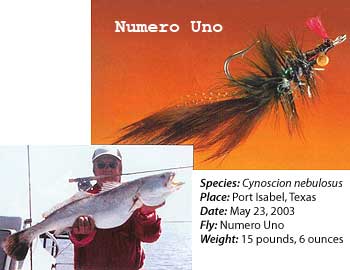 Speckled Trout
Speckled Trout
CARL “BUD” ROWLAND has caught three record speckled trout on his Numero Uno patterns. For each fish, he was either sight fishing or drifting from a boat in 6 to 8 inches of water. He caught the record 16-pound, 6-ounce speckled trout on 16-pound tippet drifting a spoil bank on the Lower Laguna Madre.
“It was midday, and there were southeasterly winds, so we had tremendous visibility. Three fish — two big ones and what I presume was one small male— swam straight at me. I figured the small fish would try to out-race the big females to the fly, so I put the fly as close to the biggest fish as a I dared, and she inhaled it.”
While Rowland weighed his catch, several bait fishers came over and acted as witnesses. As he held the fish, eggs fell onto the deck. Rowland moved to release the fish, and one of the witnesses offered him $100 for the fish. Rowland turned him down, and by releasing the fish, he disqualified himself for a state record.
“I just couldn’t kill such a genetic factor. ” he said, “Those big females surely must produce more eggs and offspring more likely to survive.”
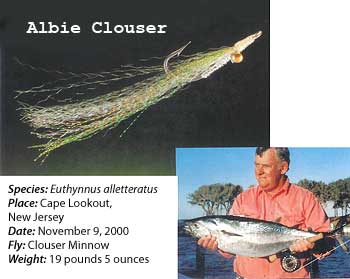 Little Tunny
Little Tunny
JIM RIVERS, whom we were unable to contact, caught his 19-pound, 5-ounce “false albacore” off of Cape Lookout, North Carolina, a.k.a. “albie Mecca.” He caught that fish during the best week of one of the best seasons in anyone’s memory. That week, the silversides were stacked in the Cape’s lee by the billions. Meanwhile, the albies attacked from below while the roseate terns performed their oddly graceful ballet amid the carnage. Around Harkers Island, large albies are keyed in on very particular protein sources, so this popular fishery has led to wonderful refinements in small baitfish patterns. Rivers caught his record on a sparsely tied Clouser Minnow, commonly called an Albie Clouser, constructed entirely from translucent, synthetic materials to imitate the translucent baitfish.
Besides the Albie Clouser, saltwater fly fishers are tying a variety of epoxy flies to imitate spearing, glass minnows, and other small baits with the same care that dry-fly tiers put into imitating tricos. Saltwater anglers are forever rhapsodizing about their ethereal qualities, though it’s doubtful one of those blue bullets will ever slow down long enough to “sip” such delicate offerings.
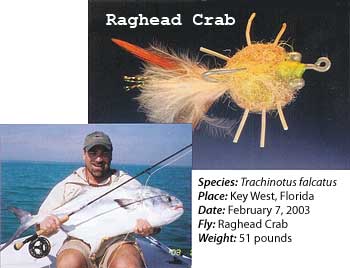 Permit
Permit
ONE OF THE more recent and most impressive saltwater records is a whopping 51-pound permit caught off Big Pine Key by Brian Eliason. Brian made the catch on a 16-pound tippet while using a Raghead Crab fly. (Editor’s Note: Eliason’s record was later rescinded by the IGFA, but the catch remains a powerful endorsement for the Raghead Crab fly pattern.)
For years, Del Brown’s Merkin has been the predominant permit pattern, and for many guides in diverse locales it remains the pattern of choice. But, early in the day, Brian’s bigger Merkin was refused repeatedly, so he switched to the smaller Raghead pattern, which the fish charged aggressively.
“It felt like I had hooked on to a windsurfer in a thirty-knot wind,” Eliason said.
Eliason had previously traveled to Belize in pursuit of his first permit, but he found Belizean fish indifferent to his quest. After booking two more trips to the Keys, the first of which was cancelled due to cold weather, he finally accomplished his goal in high style. The world-record permit towed the boat for 70 minutes, fatefully missing coral heads and lobster pots, before guide Jeff Belsik tailed the fish, then weighed and released it.
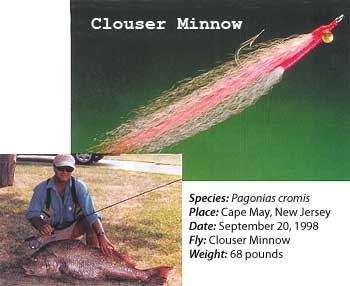 Black Drum
Black Drum
THAT BLACK DRUM aren’t all that common in the New Jersey surf makes Andy Andreychak’s 68-pound black drum an even more impressive record. Out at Cape May Point, he’d been catching lots of weakfish on the same pink Clouser Minnow. When the fish struck, Andy, who was fishing with an 8-weight, figured he’d hooked a big bass — until he beached the fish.
“He had me outclassed, that’s for sure. The tide was running out, and the tide there at the tip of New Jersey is super strong.”
A record was the furthest thing from Andy’s mind. A couple kids, however, were curious to know what the drum weighed and said they’d haul it over the dunes for him if he’d take it to a tackle shop. The fish had given Andy a 40-minute tussle and was exhausted beyond hopes of resuscitating, so Andy agreed. They took it to a shop where it was weighed. Andy went home pleased by his catch, but he had no thoughts about records. Then, after researching the catch, the shop later called him to say that the black drum was a potential world fly record.
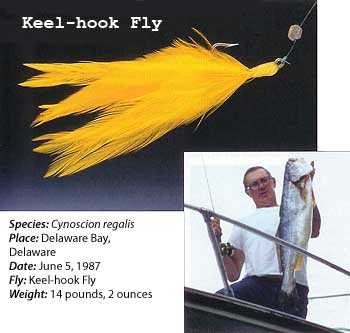 Weakfish
Weakfish
IN JUNE 1987, Norm Bartlett caught a 14-pound, 2-ounce weakfish, or gray trout, and he caught it on 4-pound tippet.
“That was during the height of the weakfish population’s cycle, and I was trying to break the 2-pound record. We went over to Delaware Bay and had planned to fish Brandywine Light. But a shop owner told us it would be a zoo out there with all the boats. He gave us the compass heading for a couple of other lights, and we found the biggest school of gray trout I’ve ever seen, daisy-chaining around 14-Foot Light like tarpon. I broke several big fish off on 2-pound tippet, then switched to 4-pound. Every cast brought a long chain of fish after the fly, and all you had to do was twitch it like a jig to make them strike. In fact, I tied the fly on a jig hook, and it looked like a jig.”
The fish ran like hell, so they released anchor and followed it all the way back around the lighthouse to where it first struck. The fish ensconced itself under a ledge, and Norm thought the fish was gone and that he was hung up. Rod straight, he pulled on the fly line as if he were hung on a branch, which pulled the fish to the surface. After 45 minutes, he lifted the record fish into the boat.
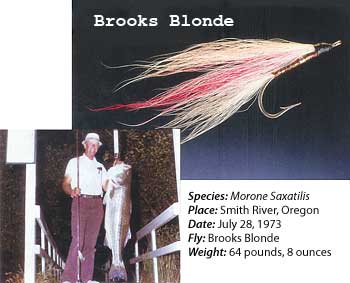 Striped Bass
Striped Bass
JOE BROOKS’S account of the capture of his record striper came out more than 35 years ago. Yet if records are made to be broken, consider the irony in Beryl Bliss catching the current world-beater on what else — a Brooks Blonde bucktail. While the application states that the 64-pound, 8-ounce monster was taken in July of 1973 on the Smith River on a 12-pound tippet, it simply refers to the fly as a “white streamer.” Fact is, the fly is a Brooks Blonde, tied with genuine embossed tinsel, which is not even manufactured anymore.
Many readers who received their introduction to saltwater fly fishing through Joe Brooks’s writing will have no difficulty recognizing the pedigree of this fly.
It’s also ironic that the striper record was caught on the West Coast, where some government agencies consider them an invasive species, during the era when East Coast striped-bass stocks collapsed. Now that the Right Coast is producing bountiful “year-classes,” and with larger fish being taken each season, one wonders how long Left Coast saltwater fly fishers will keep the striper-record bragging rights.
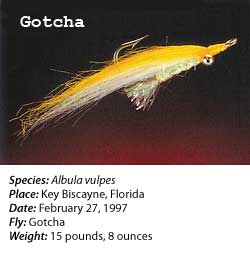 Bonefish
Bonefish
JOE PATORNO enjoyed a great year in 1997. He went to work for Jimmy Buffet, who was then working on the play Don’t Stop the Carnival. Joe was hired to set up and run the nightclub in the playhouse. The day Pantorno closed the deal with the building owners, he decided to celebrate with an afternoon of fishing with Capt. Joel Kalman in Biscayne Bay.
“It was terribly windy, I mean blowing like hell. But Joel’s a real fishy captain. We found a school of huge fish right away.” Due to the wind and churned up water, Joel was fishing with a bright, heavy, size 4 Gotcha.
“There were much bigger fish in the school than the one that took my fly,” he said. “In fact, those fish were so big, they looked like stripers schooled up on the flats.”
The fish ran off into the channel and headed straight for Mercy Hospital. It nearly spooled Joe. Almost an hour later, the fish was in the livewell. They took it to the nearest marina, weighed it, and released it. The bone weighed a whopping 15 pounds, 8 ounces.
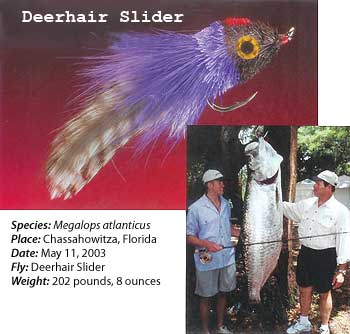 Tarpon
Tarpon
ON MAY 11, 2001, Jim Holland Jr. and his father hired Steve Kilpatrick with the explicit intent of catching a record tarpon.
After several days of tough weather and poor fishing, the weather cleared, and a run of fish appeared fresh from the ocean.
“A school of fish came down the beach. Jim Jr. tossed a Lemon Drop at them. He got three straight refusals. I told them to try that crazy hair bug we tied last night,” said Kilpatrick.
Jim Jr. made a nice long cast, and a big fish took it immediately. It tried to jump but it was so big, it got only about halfway out of the water. An hour later, it dragged them into a channel.
“A couple of bait fishermen warned us about a big shark they’d seen, and sure enough, dunuh dunuh, here comes a dorsal. I cranked up the big engine and put the boat on top of the tarpon. Every time the shark made an aggressive move, I put the Merc in neutral and revved it. Eventually the shark gave up.
“When I tried to pull the fish in the boat and couldn’t budge him, I knew this was a special fish. I can’t say why he took that crazy fly and not a traditional pattern except that when they examined the stomach contents, it was full of stuff you find offshore.”
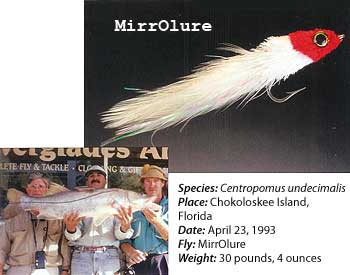 Snook
Snook
ON APRIL 23, 1993, fishing out of Chokoloskee, Florida, Rex Garret landed a 30-pound, 4-ounce snook on 20-pound class tippet. The fly that caught the record snook is a relatively obscure pattern called a MirrOlure, after the famous 52 mm plug that has been a favorite snook bait for years.
Capt. Pete Villani and Rex were poling down a muddy tidal creek just after sunup when Pete spotted the telltale yellow dorsal and tail of a finning snook. “It had been unusually cold for April,” Captain Pete said. “The sun was shining on the shallow mud flats, and I think the fish was in there trying to warm up.” According to Captain Pete, “The fish ignored the first three presentations. It sunk out of sight after the third toss, and I thought that was it. But after a little while, it popped back up.” The fourth cast landed right in front of the fish and sank with its deer hair and hackles breathing. The cold, hungry snook took the fly, and Garret took the record.











